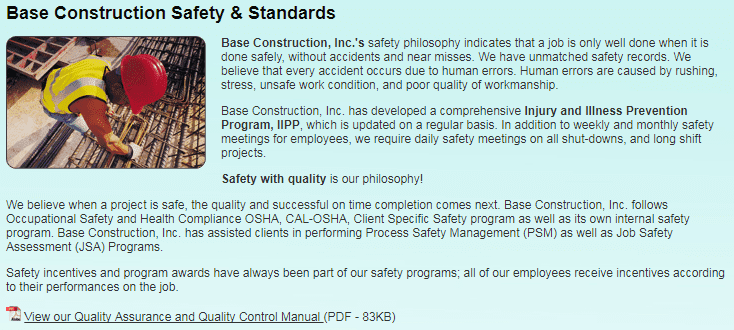At Base Construction, we treat safety seriously, taking action to protect the well-being of all of those involved in industrial field projects. In hopes that our actions will motivate other industry members to follow suit, we are presenting a 3-part series on safety practices that our Southern California company implements.
Today we’re delving into the importance of safety guards for rotating equipment.
What are Safety Guards?
Guards are on-site safety protectors that shield those working with rotating equipment from potential hazards. The benefit is that they do so without compromising quality or efficiency of a working system. We use top-quality, well-designed guards meant for strength and durability for the best protection possible of our workers. Although choosing quality equipment does increase certain expenses, the end result is worth the cost. In our industry, we can’t put a price on coworker safety.
Types of Guards for Safety Standards
Guards are of two kinds, fixed or moveable. Tests are done to determine which part is suitable for an individual machine. A fixed guard isolates the worker from possible danger through a barrier. This keeps the user out of any potential hazard zones. If users need to moderately or occasionally access the hazard zone, moveable guards are the better choice. If zone access is more frequent, specialized safety devices are advisable.
Care and caution must be taken to position any/all types of guards far enough away from danger to eliminate any chance of someone entering the hazard zone. Another step is to ensure guards are secured by proper fasteners and only removable with specialized tools to prevent detachment without authorization.
Creating Safe Work Conditions
At Base Construction we train all employees to comply with the highest safety standards and adhere to our internal Injury and Illness Prevention Program. We also follow the standards set by the U.S. Department of Labor’s Occupational Safety and Health Administration (OSHA) and Cal/OSHA. The result is superior safety records at our facility.
Regulations You can Find at Base
- OSHA’s General Regulatory Guard Requirements * Found under 1910 Subpart O – Machinery and Machine Guarding
- ANSI’s B11 Machine Guarding Standards
On-Site Industrial Safety
Base Construction operates under the safety philosophy that a job is only done well when carried out safely, without accidents or narrowly avoided issues. We choose top-of-the-line guards for rotating equipment applications to protect workers on industrial projects that range from process piping to structural steel fabrication.
For unmatched industrial contractor services for any industry, contact us today. Also, be sure to follow our blog, Twitter, and LinkedIn to stay up to date on the latest industry developments. For more information on safety take a look at our June blog and keep an eye out for part II of our safety series.
